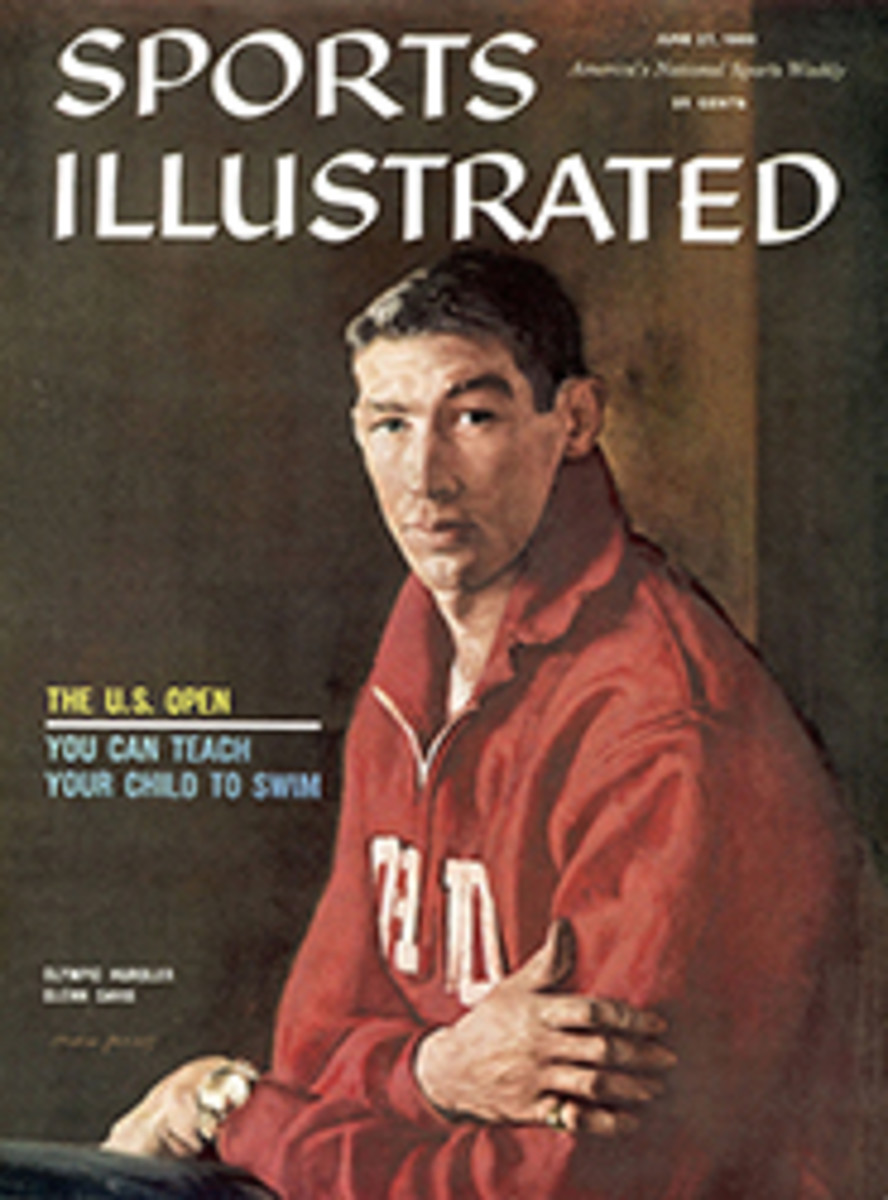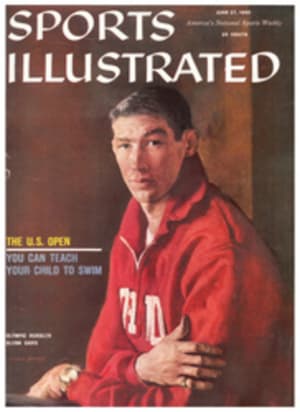
DEAD AIM ON THE OLYMPICS
The 400-meter runners boiled out of the turn and into the long run for the tape, and leading them was a third-string fullback from the University of Colorado, running his third 400-meter race outdoors. Ted Woods, a 19-year-old sophomore who is built like a quarter horse and who runs like one, pulled away from the nation's best collegians in the stretch, his thick-muscled, weight lifter's body curiously graceful. His time for the 400 meters, 45.7, set a new National Collegiate championship record and was the best in the world thus far this year.
And so Woods, a relaxed, pleasant youngster, becomes the latest in a long series of track athletes who have blossomed unexpectedly under the pressures of an Olympic year. There were other newcomers in this NCAA meet at Berkeley, but Woods seems the best bet to go on to a gold medal in Rome, just as Glenn Davis did four years ago.
"I didn't expect to get this far," Woods said after the race. "I just went out for track to have something to do between football seasons. I was a half miler in high school, and I've been running mostly sprints this year. I guess I'm pretty surprised."
Dave Mills, the crack quarter miler from Purdue who failed to make the 400-meter finals in this meet, smiled ruefully at Woods. "Lot of other people were, too," he said.
This Saturday, Woods and the other surprising youngsters on the way up meet America's Olympic veterans—some of them just reaching their peak as they fight their way back into top form—in the National AAU championships in Bakersfield, Calif. Although the meet at Berkeley was probably the finest NCAA competition in history, with 10 records broken, collegians will be favored in only five of the 19 events at Bakersfield—the 400 meters, the 800 meters, the 1,500 meters, the high jump and the javelin.
The surest undergraduate winners are John Thomas in the high jump and Dyrol Burleson in the 1,500-meter run. Thomas, who seems to be completely impervious to pressure, jumped an even 7 feet at Berkeley, then had two narrow misses at 7 feet 2 inches. Burleson, running easily, won the 1,500 meters by 20 yards in 3:44.2, roughly equivalent to a 4:02 mile, and his smooth, efficient stride was as unforced at the finish as it was at the start.
Another big collegiate favorite is George Kerr of the University of Illinois, who won the 800 meters at the NCAA meet. Kerr, a Jamaican, will run for the West Indies in the Olympics, but close behind him at Berkeley—in one of the best 800-meter races in track history—came two highly promising Americans, Jerry Siebert of California and Ernie Cunliffe of Stanford. The race presented a classic problem to Cunliffe, a wonderfully persistent runner. Ernie is not blessed with the startling speed that makes Kerr seem like a sprinter running a distance. When he goes against a runner like Kerr, Cunliffe simply cannot afford to rely on his own sprint in the event of a close finish.
Therefore, Cunliffe offered the traditional riposte to a runner with a great finishing drive; he set a fast pace, hoping either to pull far enough ahead of Kerr so that he would be out of reach down the stretch, or, if Kerr stayed with him, to exhaust the Jamaican so that he would not be able to sprint past him. Kerr did follow the pace, running two strides behind Cunliffe, with Siebert two strides behind him. These three left the rest of the field far behind. Despite the withering pace, as they hit the stretch turn of the last lap Kerr pulled wide and raced past Cunliffe. Surprisingly, Siebert went with him, passing Cunliffe, too, and for a shocking moment, seemed strong enough to challenge Kerr down the home stretch. But the Jamaican fought him off and went on to win in 1:46.4, only seven-tenths of a second off the world record and by far the best time run in the world this year.
Cunliffe finished third. "I felt fine," he said after the race. "But I'm tired of making races and not winning them. I wish someone else would set the pace."
"A runner must be much the best in the field to win setting the pace," replied Franz Stampfl, the famed European coach, who now lives in Australia, "and Kerr is the best in the world." From their fine times in this race (1:46.9 and 1:47.6), Siebert and Cunliffe must be rated as the best Americans at this distance, over Tom Murphy, who is outstanding among the postgraduate half milers.
Psychology
Still another clear-cut AAU favorite is Bill Alley, the javelin thrower from Kansas, who won his event with a towering throw of 268 feet 9 inches. In one of his warmups he threw well over 270 feet, the javelin sailing clear over the prescribed range and landing on the track.
The tremendous warmup throw was a part of the psychological battle Alley and his Kansas teammate, Terry Beucher, waged against Bob Sbordone of the University of Southern California, who had thrown more than 250 feet previously but who managed only 234 feet 5 inches in this meet. Whether Alley's pre-meet heroics "psyched him out" or not, Sbordone was far off form and finished sixth.
"We got tired of hearing about how great USC is," Alley said after he had won and Beucher had placed third. "We got a good track team at Kansas. They said we won the NCAA championship last year because USC was ineligible. I'll clue you—we'll win this year, with them in the meet." Alley was right; Kansas won with 50 points to second-place USC's 37.
A prime factor in the Kansas victory was Charlie Tidwell, a tall, slender sprinter who may challenge Ray Norton successfully in the national championships. Tidwell has an amazing lift in the last half of a race, much as Norton has, and he has the endurance to run at top form through heats and semifinals and finals. Both Norton and Tidwell appear better able to stand the grind of repeat races than Dave Sime, the other strong contender in the AAU dashes.
"I've been sore-legged for the last four weeks," Tidwell said after his victories. "Maybe it's because the weather has been cold in Kansas. Maybe I'll skip the AAU meet."
Dallas Long, USC's powerful young shotputter, set an NCAA record in the shot (61 feet 9 inches) but he may skip the AAU meet, too. "I need to work on my form," he said. "I'm up too high. I think I need the practice." Bill Nieder, Parry O'Brien and Dave Davis are entered in the AAU. Nieder, who is recovering rapidly from a pulled hamstring muscle, and O'Brien, who did 62 feet 11¼ inches Saturday night in a meet at Albuquerque, should decide the championship between them.
The rest of the NCAA winners face a difficult challenge. A typical example is Cliff Cushman of Kansas, who won the 400-meter hurdles in 50.8 seconds. Among the oldsters aiming for the Olympics is a man whose best efforts make Cushman's good time look ordinary.
Glenn Davis (see cover), who won the Olympic 400-meter hurdles at Melbourne in 1956 and who holds the world record of 49.2 seconds, did 49.9 in Albuquerque last Saturday in preparation for the AAU meet. For Davis, as for most of the veteran U.S. competitors, the road to fitness has been a long and often discouraging one. Davis teaches industrial arts in a junior high school in Columbus, Ohio, and he only began to reach his peak a couple of weeks ago. "He was worried about his speed," said his coach, Larry Snyder of Ohio State, who is also the U.S. Olympic coach. "So he worked on nothing but sprints for the last few weeks. He's all right now. He'll be as sharp as he was in 1956 next week."
Eddie Southern, who finished second to Davis in the 1956 Olympics, will probably switch to the 400-meter dash at Bakersfield. Southern, too, seems to be ready after a long, slow preparation. He has in his career run the equivalent of Ted Woods's 45.7; if he is fit, he may beat Woods at the AAU meet.
In the 110-meter hurdles, another Olympic event, Lee Calhoun, at 27 one of the older U.S. track stars, did 13.6 at Albuquerque. Calhoun, Hayes Jones, and Chuck Cobb, the big, ex-Stanford hurdler, all look better than any collegian.
Indeed, in view of the preponderance of mature talent, it is likely that this will be one of the oldest Olympic teams ever to represent the U.S. Harold Connolly, the hammer champion, is 29; Phil Coleman, one of the favorites in the steeplechase, is 29; Al Oerter, probably the best of the U.S. discus throwers, is 23; Al Cantello, the world record holder in the javelin, is 28. Don Bragg, the pole vaulter, is 25, and so is Bob Gutowski. Jim Beatty, U.S. record holder in the mile and our fastest in the 5,000 meters, is 25. And, of course, there's the senior citizen of the shot, Parry O'Brien, a ripe old 28.
PHOTO
JACK FIELDS
JAVELIN THROWER BILL ALLEY SET RECORD, HELPED KANSAS WIN NCAA TITLE
PHOTO
JACK FIELDS
19-YEAR-OLD TED WOODS WON THE 400

